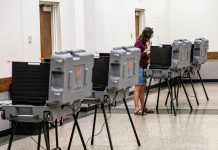The Columbus Police Department has updated its general order on use of force to include additional language about training procedures.
The general order change was approved by the Board of Works on Nov. 4. CPD Chief Michael Richardson said that it was based on a recommendation from the Commission on Accreditation for Law Enforcement Agencies, through which the CPD is accredited. The department also reviews its policies with CALEA and listens to recommendations from the commission on general orders.
The approved change includes slight revisions and additions to section 4.1.1 of general order number four. Both the old version of 4.1.1 and the new version state that use of force must be “objectively reasonable” and that officers should “apply de-escalation techniques when possible.”
The additions mainly focus on specifying what use of force training includes. The old 4.1.1 said that training included “immediate action, de-escalation, and use of distance and cover tactics and recognizing situations that do not pose an immediate threat and allow for other resources to be activated.”
The updated policy now clarifies that use of force training is specifically meant for personnel who are “authorized to use reasonable force.” The policy still states that immediate action and de-escalation should be included in the training.
The policy then states, “This training should include scenario-based training that includes the concept of proportionality, crisis recognition, effective communication, using distance and cover to create time, contact and cover responsibilities, tactical repositioning, and ‘slowing down’ situations that do not pose an immediate threat. Personnel not having sworn status are prohibited from using force in situations other than self-defense.”
Columbus Police Department spokesman Lt. Matt Harris said that while the language added to 4.1.1 is new, this kind of training is not new for officers.
“This is stuff that we already have been doing for years, in regards to scenario-based training,” he said. “It’s just put in our policy now. So we had done active shooter training earlier this month down at the fairgrounds, and we try to do this type of scenario-based training twice a year. And we’ve been doing this … essentially my whole career, which has been roughly 20 years.”
He added that the department uses different locations for the training, so as to keep it “fresh” and “realistic” for officers. CPD officers also train with the sheriff’s office and the Indiana University Police Department.
“We always prepare and train for the worst so that if there ever was an emergency that should arise, our officers would be able to handle it,” Harris said.
The final sentence of the addition to 4.1.1 states that “Personnel not having sworn status are prohibited from using force in situations other than self-defense.”
Harris clarified that a sworn employee is a law enforcement officer. Non-sworn employees, who are not law enforcement officers, include records personnel and those designated as a civilian criminal analyst.
[sc:pullout-title pullout-title=”Where to learn more” ][sc:pullout-text-begin]
The Columbus Police Department’s general orders can be viewed online at www.columbus.in.gov/police/home/general-orders/ and will be updated to reflect the approved changes.
[sc:pullout-text-end]




